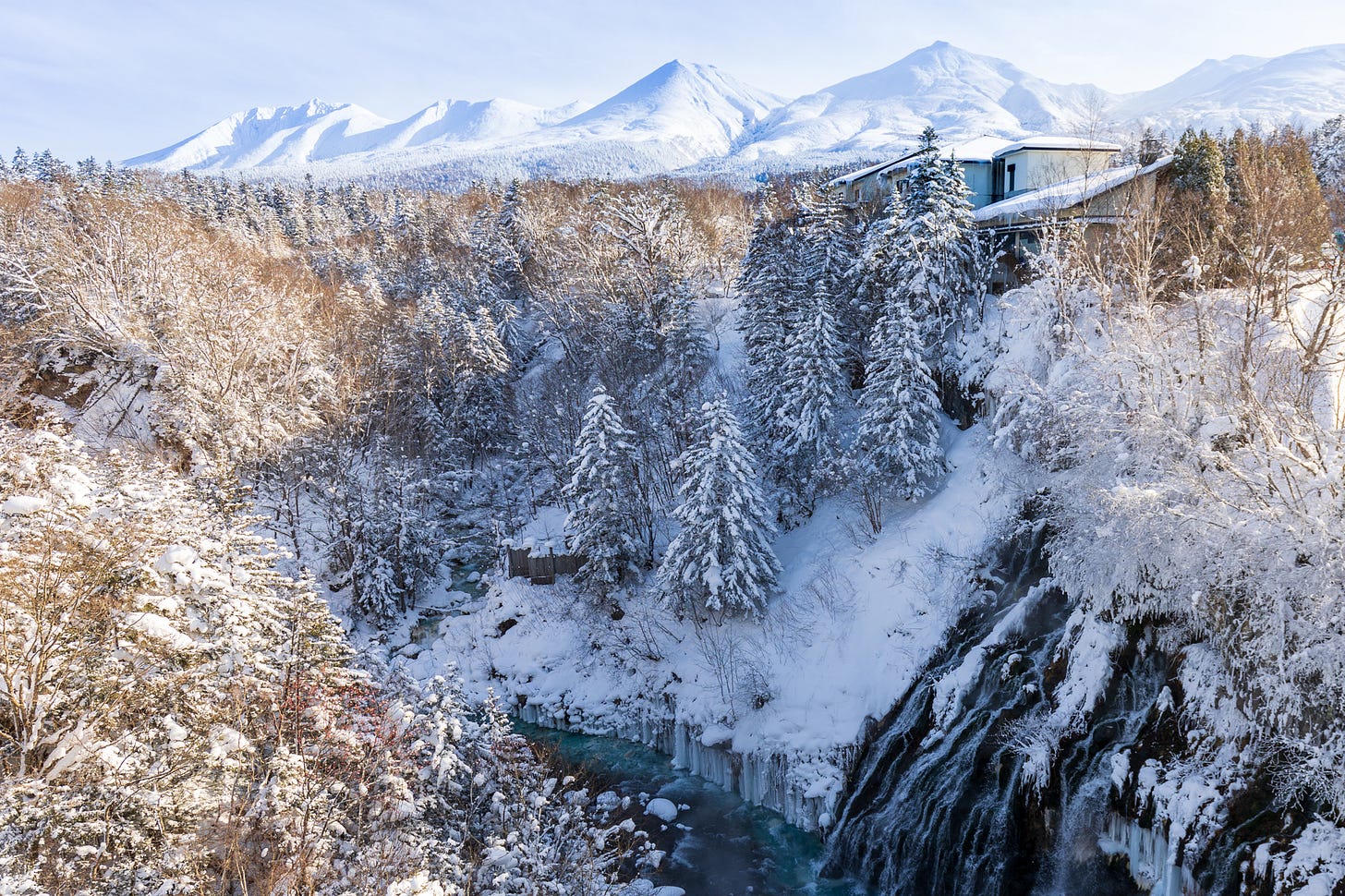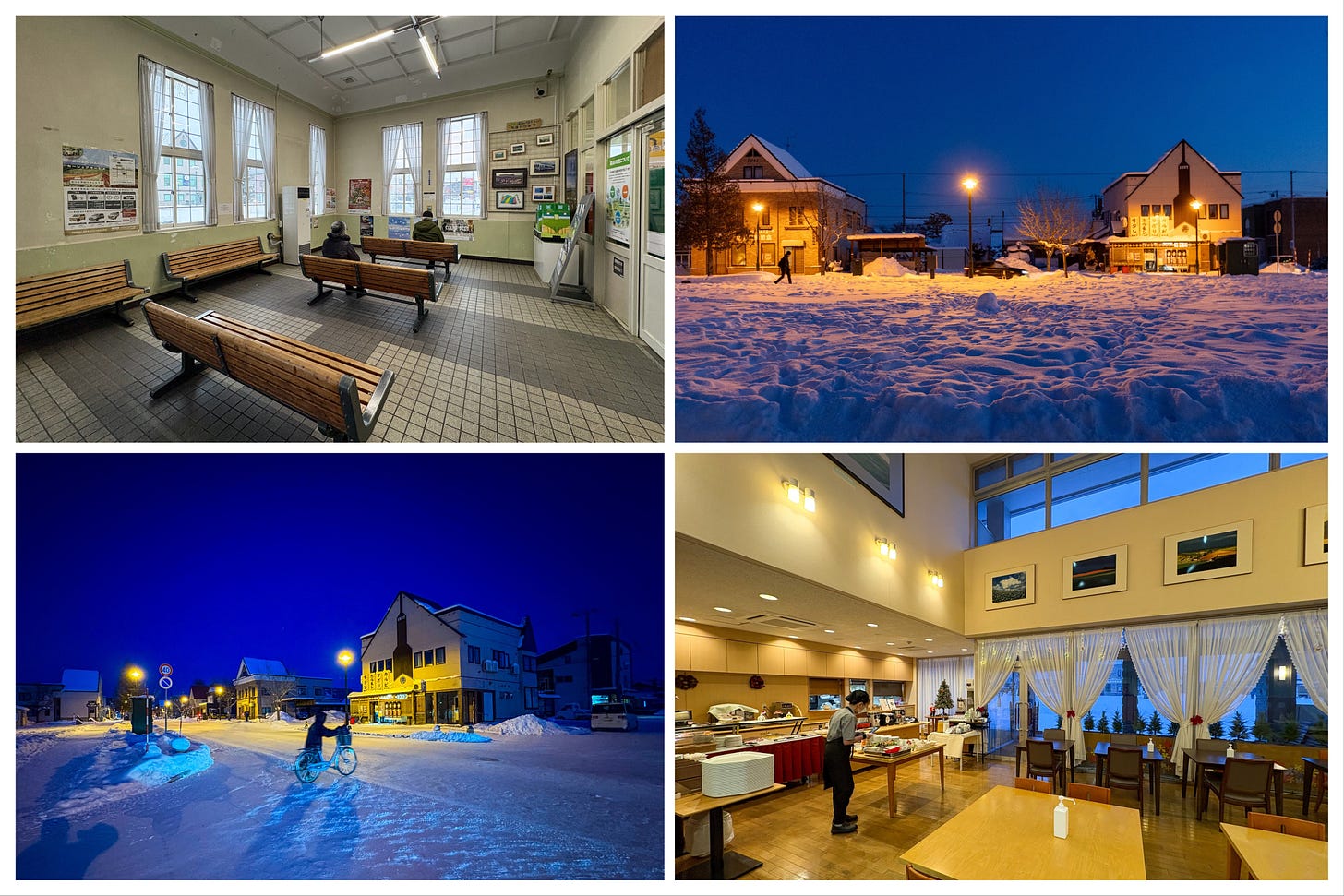Hokkaido Travel Diaries: Day 1 — Bringing out the Rainbow
Travel diaries: December 21st, Day 1 - arrival at Biei, waterfall visits, soup curry and a yakitori dinner (and Rosebud Motel).
Good morning from the other side. In Japan, we’re well into 2025, and the country is busy with hatsumōde - 初詣, the tradition of visiting a shrine or temple during the first three days of the new year to pray for good luck. The small shrine right behind my house is also open for hatsumōde, but I plan to visit the larger Taishakuten Temple, which I wrote about in the December letter.
As mentioned in Sunday’s post, this is the first entry in the Hokkaido Travel Diaries, starting with the first day of the trip, December 21st, the longest night of the year. The day includes a visit to Shirahige Waterfall, one of Japan's most iconic landscapes, followed by Shiroganefudano Waterfall, which may not be as iconic but offers a much more secluded experience. It ends with a quick stop at Blue Pond before heading back to Biei town for dinner at a lovely yakitori place. Logistical details, including access information and booking tips, will be provided in the final, fourth post of the series.
A cozy village hotel
On the shortest day of the year, I left home in the dark around 4:30 a.m. to catch my 7 a.m. flight from Haneda Airport, arriving at Asahikawa Airport just after 8:30 a.m. After a short taxi ride—since I was too impatient to wait for the public bus and risk missing the rare blue skies of winter in Hokkaido—I reached Biei around 9 a.m. I had just enough time to drop off a few items at the hotel before catching the bus to Shirahige Waterfall.
I chose to stay at Hotel Lavenir, just a few minutes from Biei Train Station. Housed in a building originally constructed in 1915, the hotel is as far from a design hotel as you can imagine. Yet, for a reasonable rate of USD 60 a night for a single room, it offers a unique appeal: warm lighting and decor that doesn’t quite belong to the Showa era but evokes a similar coziness, basic yet well-equipped rooms that are spacious by Japanese standards, and exceptionally friendly staff.
If you stretch your imagination a little—as I often do to make my travels fit the experience/feeling I’ve dreamed to have/feel before trips, which frequently makes me question my reliability as a travel narrator—you might even say that Hotel Lavenir carries a hint of Rosebud Motel from Schitt’s Creek, but with much more helpful staff and higher hygiene standards.
While Lavenir has the most central location, there are plenty of other accommodation options in town, as well as cottage-style lodgings scattered around the greater area, which I’d only recommend if you have a car.
Shirahige Waterfall — possibly the most iconic landscape scenery in Japan
After a quick stop at the hotel, I was soon in line for the bus for a 30-minute ride to Shirahige Waterfall. The line was long, and the bus was packed, with as many people standing as seated.
Having visited Shirahige Waterfall before, I knew how spectacular it was. Still, I felt a little anxious to get there as quickly as possible to catch the view on this rare sunny, and cloudless day—a sight I hadn’t experienced on my first visit. And what a sight it was! The Tokachi Mountain Range stood in full view, forming a perfect backdrop to the partially frozen waterfall, which flowed into the milky-blue waters of the narrow Biei River.
While the pedestrian bridge serving as the viewing platform was crowded, the view was so iconic and mesmerizing that, with the help of noise-canceling headphones, the experience remained incredibly engaging.
It’s well-known that the number of visitors to Japan has substantially increased in recent years, raising concerns about over-tourism and making it harder to have a more relaxed experience at popular sites. However, from a visitor’s perspective, the crowd situation in Japan still feels quite different from what I've often encountered in some of the world’s most visited cities, such as Venice, Rome, Paris, or even my home city, Istanbul. In Japan, crowds tend to cluster in specific locations, making it relatively easy to find a more secluded experience with a bit of careful planning. One street may be packed with thousands of people, while the adjacent one is very likely to be entirely empty. This was also my experience during my week-long stay in Biei, where I often found myself fully alone on narrow forest paths just beyond a famous and busy site featuring a landmark tree.1
The temperature was around -10°C, but staying outdoors didn’t feel as daunting as I had expected. So, I decided to skip the bus and walk to the Blue Pond, stopping at the less-visited Shirogane Fudo Waterfall on the way. I followed the car road, and fortunately, the traffic was relatively light. With snow partially blocking the entrances, it was easy to miss the narrow forest path that led to the waterfall.




